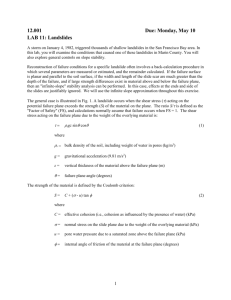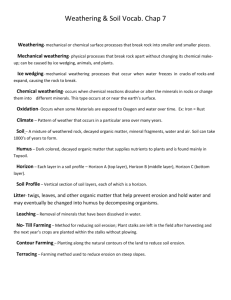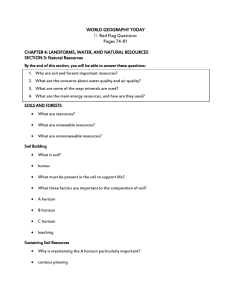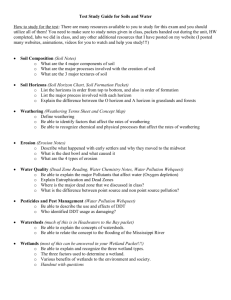STABILITY ANALYSIS OF A SHALLOW LANDSLIDE
advertisement
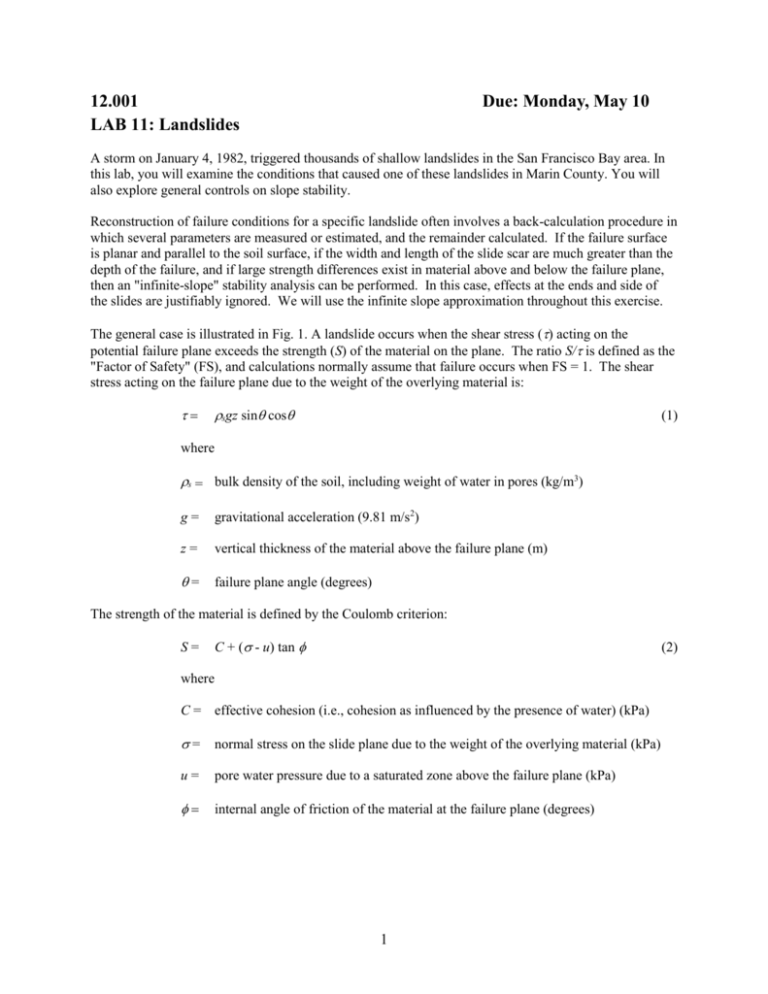
12.001 LAB 11: Landslides Due: Monday, May 10 A storm on January 4, 1982, triggered thousands of shallow landslides in the San Francisco Bay area. In this lab, you will examine the conditions that caused one of these landslides in Marin County. You will also explore general controls on slope stability. Reconstruction of failure conditions for a specific landslide often involves a back-calculation procedure in which several parameters are measured or estimated, and the remainder calculated. If the failure surface is planar and parallel to the soil surface, if the width and length of the slide scar are much greater than the depth of the failure, and if large strength differences exist in material above and below the failure plane, then an "infinite-slope" stability analysis can be performed. In this case, effects at the ends and side of the slides are justifiably ignored. We will use the infinite slope approximation throughout this exercise. The general case is illustrated in Fig. 1. A landslide occurs when the shear stress () acting on the potential failure plane exceeds the strength (S) of the material on the plane. The ratio S/ is defined as the "Factor of Safety" (FS), and calculations normally assume that failure occurs when FS = 1. The shear stress acting on the failure plane due to the weight of the overlying material is: sgz sincos where s = bulk density of the soil, including weight of water in pores (kg/m3) g= gravitational acceleration (9.81 m/s2) z= = vertical thickness of the material above the failure plane (m) failure plane angle (degrees) The strength of the material is defined by the Coulomb criterion: S= C + (- u) tan where C = effective cohesion (i.e., cohesion as influenced by the presence of water) (kPa) = normal stress on the slide plane due to the weight of the overlying material (kPa) u= pore water pressure due to a saturated zone above the failure plane (kPa) internal angle of friction of the material at the failure plane (degrees) 1 In this case, = sgz cos2 and u = mzwg cos2 where m = the fraction of the vertical thickness of the landslide that is saturated with water w = density of water (1.0 g/cm3) Other terms are defined as above. Combining (1), (2), (3) and (4) at FS = 1 yields: sgz sincosC + (s - wm) gz cos2 tan Note that if C = 0, then w m tan s tan s (6) Figure 1. Definition sketch for an infinite-slope stability analysis Evaluation of Parameters: (1) Soil bulk density at time of failure, s, can be calculated from measured values of dry bulk density and from observed or assumed water content. This requires calculating the volume of pore space, which is normally done by assuming that the solid component of the sample has a density of 2.65 g/cm3, the density of quartz. 2 Here is an example calculation for a dry bulk density of 1.33 g/cm3. To calculate the volume of pore space, it is helpful to draw a box dividing a unit of soil into pore space and solids, each with its own volume and weight. Set the volume of the solid component at 1.0 cm3, and this gives you a weight of 2.65 g for the unit of soil. Now you need the volume of pore space that will give you the measured dry bulk density; in this case, this volume is identical to the void ratio, e (defined as volume of voids/volume of solids). Volume (cm3) 1.33 g/cm 3 Weight (g) e Pore space 0 1.0 Solid 2.65 2.65 0 g 1 e cm3 Solving this equation gives e = 1.0, which implies that the soil is 50% pore spaces and 50% solids. To calculate a saturated bulk density, fill the pore spaces with water and add this weight to that of the solids. (1.0 cm3) x (1.0 g/cm3) = 1.0 g of water So the saturated bulk density is 3.65 g / 2.0 cm3 = 1.83 g/cm3 (2) Vertical thickness of the material, z, and failure plane angle, must be measured in the field. (3) Effective cohesion, C, and the internal angle of friction, , must be evaluated by laboratory or field tests. The tests should be done with water contents similar to that at time of failure. For shallow landslides in soil, it is normally assumed that the material was saturated, and the laboratory experiments are performed on saturated samples. Often a direct shear box is used to evaluate C and in the laboratory. Undisturbed samples are placed in a split box, subjected to a confining pressure, and then the upper box is pulled with sufficient force to cause failure in the material between the two boxes. Values of effective normal stress and shear stress are then plotted as shown in Fig. 2. According to Eq. (2), the intercept is the effective cohesion (C), and the slope of the line is the tangent of the internal angle of friction (). In coarse-textured soils, the effective cohesion is usually found to be zero in the laboratory, whereas stability analyses like the one in this lab indicate that the soils must have had strength, presumably due to an apparent cohesion supplied by plant roots. In forested landscapes like those in the Pacific Northwest, apparent cohesion due to plant roots is a major component of soil strength. 3 kPa 25 20 50 40 100 80 tan 0.80 Figure 2.The y-intercept is the effective cohesion, and in this example the soil is cohesionless. (4) The fraction of the slide thickness that was saturated at the time of failure, m, has rarely been observed. It is common to assume that in shallow, planar landslides, the entire mass that failed was saturated (m = 1). 4 Assignment The following exercise is designed to provide familiarity with the above equations and to gain insight into the significance of the various parameters contained in the equations. Show all work on separate sheets of paper, and include these when you hand in your lab. The landslide we will examine occurred on a 30° slope beneath a cover of California laurel and coast live oak in a thick deposit of soil (Fig. 3). Landslides in the 1982 storm commonly occurred within the B horizon, where there may have been differences in texture and permeability that made the upper portion of the B horizon less stable. Engineering tests performed on the two horizons illustrated in Fig. 3 gave the following results: Dry Bulk Density: Direct Shear Data: (1) A horizon: B horizon: 1.29 g/cm3 1.68 g/cm3 (kPa) A horizon 10.0 20.0 40.0 7.0 14.0 28.0 B horizon 15.0 30.0 50.0 15.5 31.1 51.8 Calculate the saturated bulk density as shown in the example. A horizon s = ______ B horizon s = ______ (2) Make a graph like Fig. 2 for each horizon, and compute the internal angles of friction. A horizon = ______ B horizon = ______ Include these graphs when you hand in your lab. (3) Assume that the soil was saturated to the surface. Compute the apparent cohesion necessary for FS to equal 1 at saturation. First assume that the failure plane was at the boundary between the A and B horizons (Case 1). Then repeat the calculation assuming that the failure plane was within the B horizon, 2 m below the surface (Case 2, Fig. 3). For the second calculation you will need to compute the normal and shear stress using both the bulk densities of the A and B horizons: = [s (A horizon) (1.0 m) + s (B horizon) (1.0 m)] g cos2 and s (A horizon) (1.0 m) + s (B horizon) (1.0 m))] g sincos 5 Tabulate values of u, and C. Give your answers in kPa. u C Case 1 Case 2 What percent of the total strength of the soil is due to cohesion in each case? Case 1 Case 2 (4) Assume the soil was cohesionless. Compute the level of saturation, m, necessary for failure for each case. Case 1: m = Case 2: m = (5) Landslides play a major role in transporting debris from hillslopes in the California Coast Ranges. Hillslopes may tend to be eroded to their maximum stable angle by landslides. Assume that these landslides occur when the soil is saturated. What would be the maximum stable hillslope angle if: a. The soil is cohesionless and has the internal angle of friction of the A horizon? max = b. The soil is cohesionless and has the internal angle of friction of the B horizon? max = Equation 5 can be rewritten for fully saturated soils (m = 1) as: s C tan tan s w s w gz cos2 Using this equation, construct a graph of maximum stable angle, max, vs. internal angle of friction, . On the graph, show a line for each of the following: 1) 2) 3) 4) C = 0, z = 0.5 m C = 0, z = 2.0 m C = 1500 Pa, z = 0.5 m C = 1500 Pa, z = 2.0 m The vertical axis of the graph should be max and should range from 0° to 70°, and the horizontal axis of the graph should be . Use different markers to show your calculated values for the four 6 cases, and label all lines. In all cases, let s = 1.8 g/cm3. Note that C = 1500 Pa may be typical of shallow landslides in grasslands in Marin County. (6) Discuss the general importance of cohesion, internal angle of friction, soil depth, and degree of soil saturation in determining hillslope stability of potential shallow landslides. Contrast relative stability in forested and grassland soils. Refer to calculations and graphs previously constructed. Limit your discussion to two paragraphs or less. Figure 3. Schematic cross section of upper portion of colluvial deposit on a 30° hillslope. The A horizon is the uppermost, organic-rich zone in the soil. The B horizon contains less organic material, more rock fragments, and more clay. The C horizon (not shown here) contains weathered bedrock that retains its original structure and has not been transported downslope. In the scenario shown here, the boundary between the A and B horizons is 1 m deep, and the landslide failure plane is 2 m deep. 7
